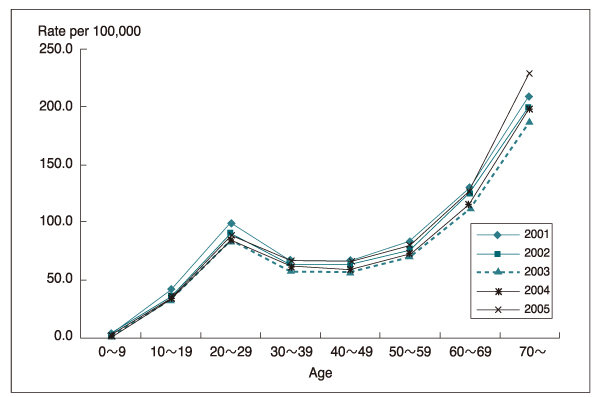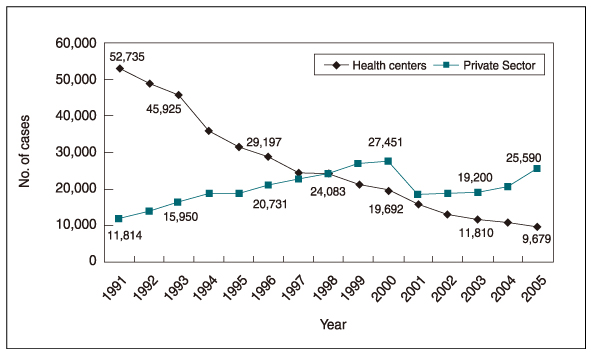Current Situation of Tuberculosis and Its Control in Korea
- Affiliations
-
- 1Department of Technical Cooperation, Korean Institute of Tuberculosis, Korean National, Tuberculosis Assciation, Korea. hatchingbird@yahoo.co.kr
- KMID: 2137816
- DOI: http://doi.org/10.5124/jkma.2006.49.9.762
Abstract
- The prevalence of tuberculosis (TB) has declined owing to the establishment of national tuberculosis (TB) program in 1962, introduction of short course chemotherapy in mid 1980's, economic development, and nationwide medical insurance system. However, it is assumed that 18,000 (0.039%) smear positive and 224,000 (0.32%) radiologically active TB patients are present in 2006 by the extrapolating the figures from the prevalence surveys during the period 1980~1995. The prevalence survey was shifted to an Internet-based notification system in June 2000, and a total of 46,969 (97.3/10(5)) patients were notified in 2005. Among them, 72.3% were registered from private sector. The proportion of patients treated at private sector is increasing year by year. Among the 35,269 (73.0/10(5)) newly diagnosed patients, 11,638 (24.1/10(5)) were smear positive pulmonary TB. The number of newly diagnosed extra-pulmonary TB patients was 5,171 (10.7/10(5)). The age distribution curve showed a peak in the young generation, which implies that TB is still prevalent in Korea. A total of 2,948 (6.1/10(5)) patients died of TB in 2004. The median age increased from 49 in 1983 to 70 in 2004. The initial drug resistance rate had been 10.4% in 1994 and rose to 12.8% in 2004. In addition, the rate of initial multi-drug resistance was significantly increased from 1.6% to 2.7% during the same period. The treatment success rate in public sector is around 80%, but it is lower in private sector due to the difficulties in the management of active diseases. To accelerate the elimination of TB, it is important to intervene in the management of patients under treatment at private sector through public-private collaborations and active investigations on the preventive therapy to manage latent infection.
Keyword
MeSH Terms
Figure
Cited by 5 articles
-
Modern History of Tuberculosis in Korea
Jae-Hoon Song, Kyungmin Huh, Doo Ryeon Chung
Infect Chemother. 2019;51(4):414-426. doi: 10.3947/ic.2019.51.4.414.Extensively Drug Resistant-Tuberculosis, XDR-TB
Jae Seuk Park
J Korean Med Assoc. 2008;51(2):168-175. doi: 10.5124/jkma.2008.51.2.168.Lung Infection Caused by Mycobacterium riyadhense Confused with Mycobacterium tuberculosis: The First Case in Korea
Jung-In Choi, Ji-Hun Lim, Sung-Ryul Kim, Seon Ho Lee, Jae-Sun Park, Kwang Won Seo, Jae Bum Jeon, Joseph Jeong
Ann Lab Med. 2012;32(4):298-303. doi: 10.3343/alm.2012.32.4.298.Tuberculosis Relief Belt Supporting Project (Tuberculosis Patient Management Project for Poverty Group)
Jae Kyoung Kim, Ina Jeong, Ji Yeon Lee, Jung Hyun Kim, Ah Yeon Han, So Yeon Kim, Joon Sung Joh
Tuberc Respir Dis. 2018;81(3):241-246. doi: 10.4046/trd.2017.0043.Analysis of the Causes of Nephrectomy in 1980–2005
Chung Ho Cho, Ki Kyung Kim
Korean J Urol. 2007;48(8):775-781. doi: 10.4111/kju.2007.48.8.775.
Reference
-
1. World Health Organization. WHO Report 2006. Global Tuberculosis Control. Surveillance, Planning, Financing. World Health Organization. 2006. WHO/HTM/TB;362.2. Ministry of Health and Welfare. Korean National Tuberculosis Association. Report on the 7th tuberculosis prevalence survey in Korea. 1995. 1996. Seoul: Ministry of Health and Welfare, Korean National Tuberculosis Association;(Korean).3. Hong YP, Kim SJ, Lew WJ, Lee EK, Han YC. The seventh nationwide tuberculosis prevalence survey in Korea, 1995. Int J Tuberc Lung Dis. 1998. 2:27–36.4. Bleiker MA, Sutherland I, Styblo K, ten Dam HG, Misljenovic O. Guidelines for estimating the risk of tuberculosis infection from tuberculin test results in a representative sample of children. Bull Union Tuberc Lung Dis. 1989. 64(2):7–12.5. Styblo K. Selected paters, Vol 24 Epidemiology of tuberculosis. 1991. Hague, The Netherlands: Royal Netherlands Tuberculosis Association.6. Kim SJ, Hong YP, Lew WJ, Yang SC, Lee EG. Incidence of pulmonary tuberculosis in Korean civil servants. Tubercle and Lung Disease. 1995. 76:534–539.
Article7. Bai GH, Kim SJ, Lee EK, Lew WJ. Incidence of pulmonary tuberculosis in Korean civil servants: second study, 1992 - 1994. Int J Tuberc Lung Dis. 2001. 5:346–353.8. Korea Centers for Disease Control and Prevention. Korean Institute of Tuberculosis. . Annual report on the notified tuberculosis patients in Korea. 2005 (Based on Korean Tuberculosis Surveillance System) Korea Centers for Disease Control and Prevention. 2006. Korean Institute of Tuberculosis.9. Kim CH, Koh WJ, Kwon OJ, Ahn YM, Lim SY, et al. The accuracy of tuberculosis notification reports at a private genereal hospital after enforcement of new Korean tuberculosis surveillance system. Tuberc Respir Dis. 2003. 54:178–190.
Article10. Korea National Statistical Office. 2004 Annual report on the cause of death statistics (Based on vital registration) Korea National Statistical Office. 2005. Seoul:11. World Health Organization. WHO/TB/97. 229. Anti-tuberculosis drugs resistance in the world. The WHO/IUATLD global project on anti-tuberculosis drug resistance surveillance. WHO Global Tuberculosis Programme. Geneva:12. World Health Organization. WHO/TB/2000. 278. Anti-tuberculosis drugs resistance in the world Report No.2 Prevalence and trends. The WHO/IUATLD global project on anti-tuberculosis drug resistance surveillance. 2000. Communicable diseases World Health Organization:13. Bai GH. Anti-tuberculosis drug resistance in Korea. CDMR. 2005. 16:101–107.14. Chang CL, Lee EY, Park SK, Jeong SH, Park YK, et al. A Trend in Acquired Drug Resistances of Tuberculosis Patients Registered in Health Centers from 1981 to 2004. Tuberc Respir Dis. 2005. 59:619–624.
Article15. Kim DK, Kim MO, Kim TH, Sohn JW, Yoon HJ, et al. The Prevalence and Risk Factors of Drug Resistant Pulmonary Tuberculosis Investigated at One University Hospital in Seoul. Tuberc Respir Dis. 2005. 58:243–247.
Article16. Jung YJ, Park IN, Hong SB, Oh YM, Lim CM, et al. The clinical characteristics, diagnosis, treatment, and outcomes of patients with tuberculosis at a private university hospital in Korea. Tuberc Respir Dis. 2006. 60:194–204.
Article17. Son CH, Yang DG, No MS, Jeong JS, Lee H, Lee GN, et al. Prevalence of drug-resistances in patients with pulmonary tuberculosis and its association with clinical characteristics at one tertiary referral hospital in Pusan, Korea. Tuberc Respir Dis. 2001. 51:416–425.
Article18. Kim JH, Kim JH, Jang TW, Jung MH. Drug-resistant pulmonary tuberculosis in Kosin Medical Center. Tuberc Respir Dis. 1995. 42:831–837.
Article19. Hong YP, Kim SJ, Lew WJ, Lee SH, Lee EK. Cohort analyses of the treatment of smear-positive pulmonary tuberculosis patients under programme conditions in Korea, 1983-1994. Int J Tuberc Lung Dis. 1998. 5. 2:365–371.20. Korean Institute of Tuberculosis. A follow up study for the transferred out and defaulters among the bacteriologically positive patients under the national tuberculosis programme. 1999. Seoul: Korean Institute of Tuberculosis.21. Jang DJ, Jin BW. An Analysis of Tuberculosis Patient Management in Private Sector. Tuberc Respir Dis. 1990. 37:399–406.
Article22. Hong YP, Kim SJ, Lee EG, Lew WJ, Bai JY. Treatment of bacillary pulmonary tuberculosis at the chest clinics in the private sector in Korea, 1993. Int J Tuberc Lung Dis. 1999. 3:695–702.23. Kim YO, Yang WH, Bae JM. A survey of the controlling system for the pulmonary tuberculosis in Jejudo, 2002. Tuberc Respir Dis. 2004. 56:356–363.
Article24. Koh WJ, Kwon OJ, Kim CH, Ahn YM, Lim SY, et al. Clinical characteristics and treatment outcomes of patients with pulmonary tuberclosis at a private general hospital. Tuberc Respir Dis. 2003. 55:154–164.
Article25. Kim HJ, Bai GH, Kang MK, Kim SJ, Lee JK, et al. An intervention trial of a public-private collaboration model for improving treatment outcomes of tuberculosis patients in the private sector in Korea. Int J Tuberc Lung Dis. 2005. 9:Suppl 1. S55.26. World Health Organization. WHO/HTM/TB/2004.338. Public-Private Mix for DOTS. Global progress. Report of the Second Meeting of the PPM Subgroup for DOTS Expansion. World Health Organization.27. Korea Center for Disease Control and Prevention. Tuberculosis Guidelines. 2006. Korea Center for Disease Control and Prevention. KCDC 06-15. 2006. Seoul: 5. (Korean).
- Full Text Links
- Actions
-
Cited
- CITED
-
- Close
- Share
- Similar articles
-
- Tuberculosis Management of Private Health Care Institution: Current Situation and Task
- A Study on the Drug Susceptibility Test of Multi-Drug Resistant Tuberculosis Patients
- Tuberculosis Situation in Korea
- Study on Tuberculosis Control of Those Patients who Registered at Health Center
- Personnel Management of Tuberculosis Workers: A Survey on the Job, Training and Performance of the Field Workers in Korea




